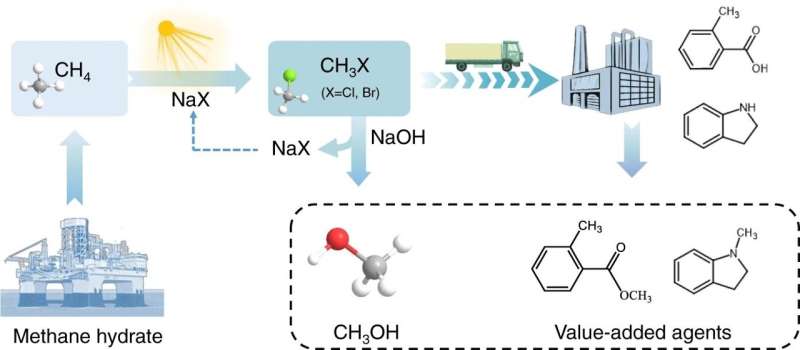This article has been reviewed according to Science X's editorial process and policies. Editors have highlighted the following attributes while ensuring the content's credibility:
fact-checked
peer-reviewed publication
proofread
A breakthrough in sustainable methane utilization technology

99.5% of combustible ice is methane, making it an important reserve energy source. It is inferred that the reserves of combustible ice in the South China Sea amount to the equivalent of at least 80 billion tons of oil.
Current mining methods will lead to the gasification of the combustible ice during the decompression process, which poses a great challenge for the storage and transportation of methane gas. If the methane can be converted into liquid products offshore, it will provide a new prospect for the utilization of combustible ice.
In light of that, a team led by Prof. Xiong Yujie and Prof. Long Ran from the University of Science and Technology (USTC) developed an efficient photocatalytic methane halogenation technology using only light, methane and seawater, the products of which can further transform into methanol and pharmaceutical intermediates. Their work was published in Nature Communications.
As a type of versatile platform molecule, methyl halides are widely used in the production of high value-added chemicals and fuels such as methanol, acetic acid and propylene. However, the current synthesis of methyl halides usually involves corrosive feedstocks such as chlorine and hydrogen bromide and harsh reaction conditions, which not only requires complex processes and huge energy consumption, but also poses potential threat to the environment.
The research team designed a copper-doped titania catalysis and used widely available alkali halides as halogenation agent to achieve efficient synthesis of methyl halides under light with production rate reaching 1 mmol h-1m-2. This method takes advantage of the offshore light and seawater conditions to efficiently convert methane into chloromethane, verifying the practicability of photocatalytic methane chlorination technology in the utilization of combustible ice.
Based on this technology, the team designed a tandem reaction device to synthesize methanol and pharmaceutical intermediates with methane. This work blazes a trail for the exploitation of combustible ice and the conversion from methane to high value-added chemical products.
More information: Jun Ma et al, Sustainable methane utilization technology via photocatalytic halogenation with alkali halides, Nature Communications (2023). DOI: 10.1038/s41467-023-36977-0
Journal information: Nature Communications
Provided by University of Science and Technology of China





















